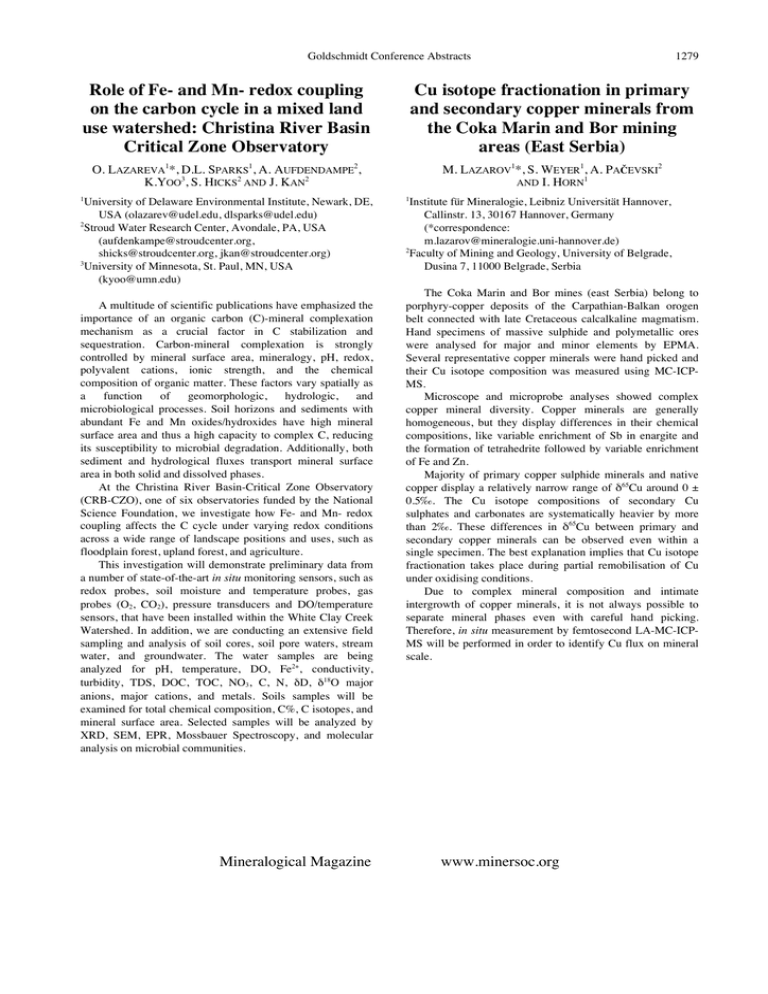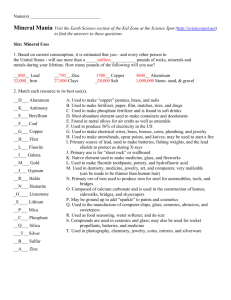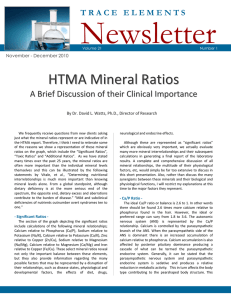Role of Fe- and Mn- redox coupling
advertisement

Goldschmidt Conference Abstracts Role of Fe- and Mn- redox coupling on the carbon cycle in a mixed land use watershed: Christina River Basin Critical Zone Observatory Cu isotope fractionation in primary and secondary copper minerals from the Coka Marin and Bor mining areas (East Serbia) O. LAZAREVA1*, D.L. SPARKS1, A. AUFDENDAMPE2, K.YOO3, S. HICKS2 AND J. KAN2 University of Delaware Environmental Institute, Newark, DE, USA (olazarev@udel.edu, dlsparks@udel.edu) 2 Stroud Water Research Center, Avondale, PA, USA (aufdenkampe@stroudcenter.org, shicks@stroudcenter.org, jkan@stroudcenter.org) 3 University of Minnesota, St. Paul, MN, USA (kyoo@umn.edu) 1 A multitude of scientific publications have emphasized the importance of an organic carbon (C)-mineral complexation mechanism as a crucial factor in C stabilization and sequestration. Carbon-mineral complexation is strongly controlled by mineral surface area, mineralogy, pH, redox, polyvalent cations, ionic strength, and the chemical composition of organic matter. These factors vary spatially as a function of geomorphologic, hydrologic, and microbiological processes. Soil horizons and sediments with abundant Fe and Mn oxides/hydroxides have high mineral surface area and thus a high capacity to complex C, reducing its susceptibility to microbial degradation. Additionally, both sediment and hydrological fluxes transport mineral surface area in both solid and dissolved phases. At the Christina River Basin-Critical Zone Observatory (CRB-CZO), one of six observatories funded by the National Science Foundation, we investigate how Fe- and Mn- redox coupling affects the C cycle under varying redox conditions across a wide range of landscape positions and uses, such as floodplain forest, upland forest, and agriculture. This investigation will demonstrate preliminary data from a number of state-of-the-art in situ monitoring sensors, such as redox probes, soil moisture and temperature probes, gas probes (O2, CO2), pressure transducers and DO/temperature sensors, that have been installed within the White Clay Creek Watershed. In addition, we are conducting an extensive field sampling and analysis of soil cores, soil pore waters, stream water, and groundwater. The water samples are being analyzed for pH, temperature, DO, Fe2+, conductivity, turbidity, TDS, DOC, TOC, NO3, C, N, "D, "18O major anions, major cations, and metals. Soils samples will be examined for total chemical composition, C%, C isotopes, and mineral surface area. Selected samples will be analyzed by XRD, SEM, EPR, Mossbauer Spectroscopy, and molecular analysis on microbial communities. Mineralogical Magazine 1279 M. LAZAROV1*, S. WEYER1, A. PA!EVSKI2 1 AND I. HORN Institute für Mineralogie, Leibniz Universität Hannover, Callinstr. 13, 30167 Hannover, Germany (*correspondence: m.lazarov@mineralogie.uni-hannover.de) 2 Faculty of Mining and Geology, University of Belgrade, Dusina 7, 11000 Belgrade, Serbia 1 The Coka Marin and Bor mines (east Serbia) belong to porphyry-copper deposits of the Carpathian-Balkan orogen belt connected with late Cretaceous calcalkaline magmatism. Hand specimens of massive sulphide and polymetallic ores were analysed for major and minor elements by EPMA. Several representative copper minerals were hand picked and their Cu isotope composition was measured using MC-ICPMS. Microscope and microprobe analyses showed complex copper mineral diversity. Copper minerals are generally homogeneous, but they display differences in their chemical compositions, like variable enrichment of Sb in enargite and the formation of tetrahedrite followed by variable enrichment of Fe and Zn. Majority of primary copper sulphide minerals and native copper display a relatively narrow range of !65Cu around 0 ± 0.5‰. The Cu isotope compositions of secondary Cu sulphates and carbonates are systematically heavier by more than 2‰. These differences in !65Cu between primary and secondary copper minerals can be observed even within a single specimen. The best explanation implies that Cu isotope fractionation takes place during partial remobilisation of Cu under oxidising conditions. Due to complex mineral composition and intimate intergrowth of copper minerals, it is not always possible to separate mineral phases even with careful hand picking. Therefore, in situ measurement by femtosecond LA-MC-ICPMS will be performed in order to identify Cu flux on mineral scale. www.minersoc.org








